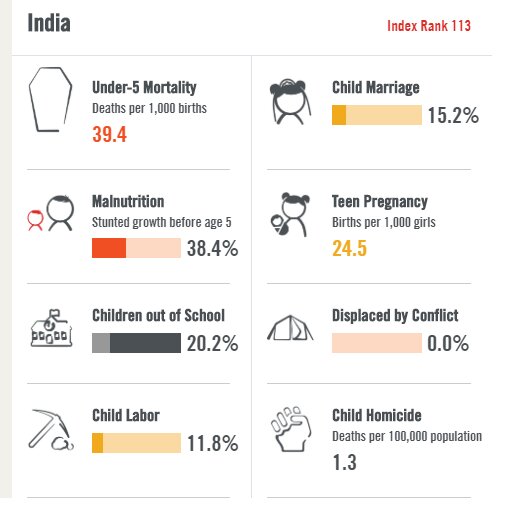Social Justice
Childhood Index
- 10 Jun 2019
- 5 min read
India ranks 113 of 176 countries on an index that evaluates countries on the wellbeing of children. The End of Childhood Index is part of the Global Childhood Report released by UK-based Save the Children, a non-profit organisation that works for child rights.
- The index evaluates countries on eight indicators to determine the wellbeing of children and teenagers (0-19 years):
- Mortality among children under five years of age
- Malnutrition that stunts growth
- Lack of education
- Child labour
- Early marriage
- Adolescent Births
- Displacement by conflict
- Child homicide
- A final score out of 1,000 is derived, and countries are ranked accordingly.
Performance of India
- Child mortality: India has reduced its child mortality rate by 55% in the last two decades, from 88 deaths per 1,000 live births in 2000 to 39 deaths per 1,000 live births in 2017.
- Among neighbouring countries, India’s performance on under-five mortality was better only than that of Pakistan (74.9). Sri Lanka (8.8), China (9.3), Bhutan (30.8), Nepal (33.7) and Bangladesh (32.4) have all outperformed India.
- These deaths are mostly attributed to preventable infectious diseases, followed by injuries, meningitis, measles and malaria.
- Stunting of children: low height for age, among children below age five, fell 25% globally from 198 million children to 149 million between 2000 and 2019.
- In India about 38% of children under five were stunted, the second-worst performance compared to its neighbours after Pakistan (40.8%). China (6%) had the lowest rate in the region, followed by Nepal (13.8%), Sri Lanka (17.3%), Bangladesh (17.4%) and Bhutan (19.1%).
- There are wide disparities between states in India – while 48.3% children are stunted in Bihar, 45.3% in Jharkhand and 37.6% in Chhattisgarh, Kerala has the least at 19%, followed by Tamil Nadu (27.1%)
- Free universal education: despite India’s advances at giving free universal education to its children, about 20% of them (aged 8-16) were still out of school as of 2018.
- Compared to its neighbours, India performed better only than Pakistan (40.8%), while Sri Lanka (6.4%), Nepal (13.8%), Bangladesh (17.4%), Bhutan (19.1%) and China (7.6%) did better.
- Child marriages: India halved its number of child marriages in 18 years to 2018, while marriage rates for the poorest girls fell at least as much as for everyone else.
- The decline has been fastest among girls younger than 15.
- India had raised the minimum age of marriage from 15 to 18 for girls and from 18 to 21 for boys.
- Adolescent births: India has managed to reduce adolescent births by 63% since 2000, which has resulted in 2 million fewer young mothers.
- India alone accounts for nearly three-quarters of the global reduction in adolescent births – from 16 million to 13 million.
- Adolescent birth rate (births per 1,000 girls aged 15-19 years)- In India, it was 24.5 %, higher than that in China (6.5 %), Sri Lanka (14.8 %) and Bhutan (22.1%), and better than that in Pakistan (37.7%), Nepal (62.1%) and Bangladesh (84.4%) as of 2018.
Conclusion
- Much of India’s progress has been the result of its social welfare programmes that have enabled more girls to stay in school and increased access to sexual and reproductive health services.
- India has worked to curb child marriage through legislation such as the Prohibition of Child Marriage Act, 2006.
- Community-based interventions such as empowerment counselling, sexual and reproductive health information, vocational training and life-skills development for girls have also been important factors.
- Schemes such as conditional cash transfers to educate the girl child have also helped reduce child marriage
- Schemes such as the Rajiv Gandhi Scheme for Empowerment of Adolescent Girls (called SABLA), Kishori Shakti Yojana and Nutrition Programme for Adolescent Girls have led to the improvement in the health of Adolescent Girls.
- An increase in public investments, and intervention through programmes targeted at marginalised children to ensure universal healthcare and education are further needed to improve the wellbeing of children.






